【ASP.NET MVC系列】浅谈ASP.NET MVC资源过滤和授权
最近比较忙,博客很久没更新了,很多博友问何时更新博文,因此,今天就花了点时间,写了本篇文章,但愿大家喜欢。
本篇文章不适合初学者,需要对ASP.NET MVC具有一定基础。
本篇文章主要从ASP.NET MVC 基架角度去分析MVC框架是如何实现资源过滤,资源授权,感兴趣的,欢迎阅读。
相关文章,请参与ASP.NET MVC系列
一 ASP.NET MVC框架验证机制
为了更加透彻地了解MVC的过滤机制,我简要地画了如下UML图。
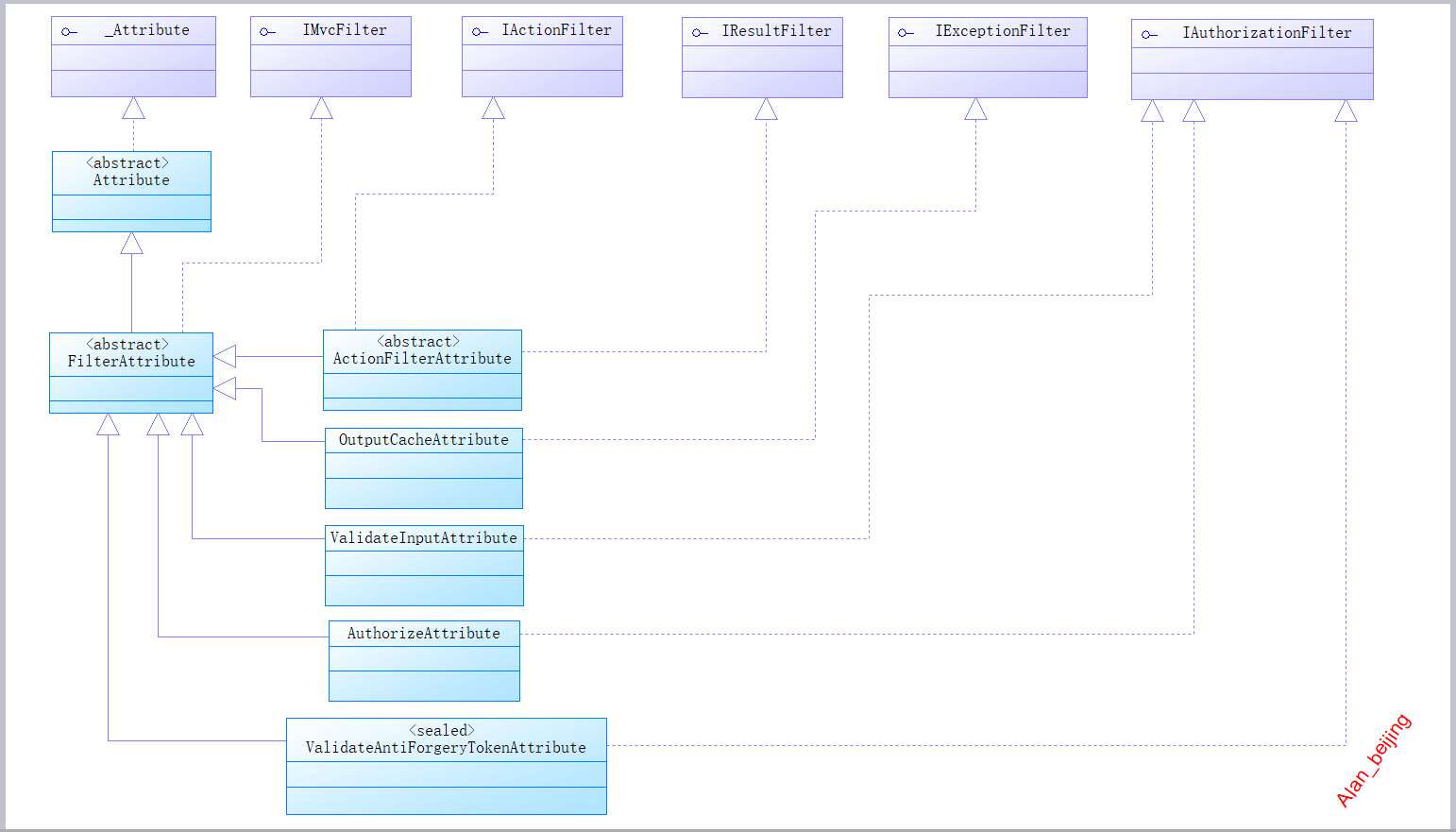
下面,我们根据如上的UML图来简要分析一下。
(一)MVC基架过滤机制根接口
根接口:本文指在继承关系中的根节点,相当于类的祖宗对象Object。
从上图中,很容易看出MVC过滤机制的根接口主要有六大类型接口:_Attribute,IMvcFilter,IActionFilter,IResultFilter,IExceptionFilter和IAuthorizationFilter。
1._Attribute
_Attribute接口主要提供一些非托管服务。

2.IMvcFilter
该接口主要用于定义筛选器顺序和是否允许多个筛选器,如当我们给某个action限定多个特性时的执行顺序问题。
[Filter1(Order = )]
[Filter2(Order = )]
[Filter3(Order = )]
public ActionResult Index()
{
return View(); ;
}

3.IActionFilter
该接口主要定义操作的筛选,在执行操作方法前后,分别调用方法OnActionExecuting(ActionExecutingContext filterContext)和方法OnActionExecuted(ActionExecutedContext filterContext)。IResult也有类似两个方法。
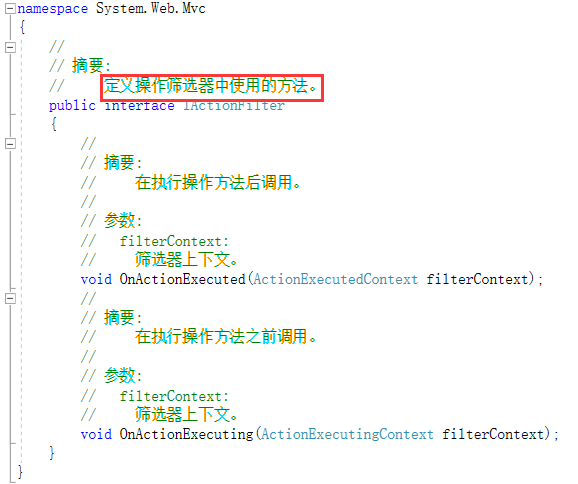
4.IResultFilter
该接口主要用作操作结果的筛选。对于MVC模式开发的程序员来说,ActionResult再熟悉不过了,然而,MVC机制会在操作结果执行前后,分别执行OnResultExecuting(ResultExecutingContext filterContext)方法和OnResultExecuted(ResultExecutedContext filterContext)方法,然后再将最终结果Responce给用户,
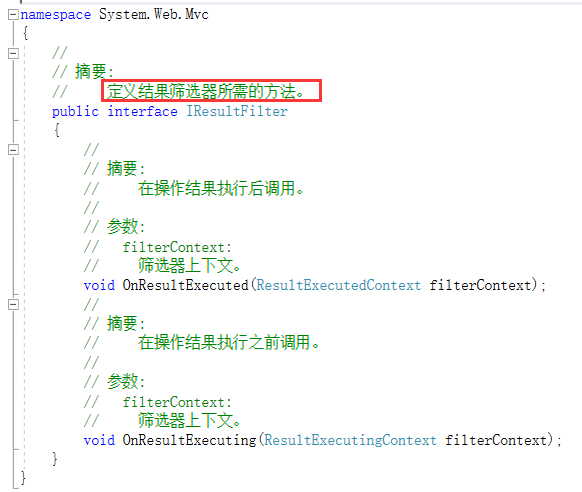
5.IExceptionFilter
该接口主要是用来处理系统异常问题,如在项目中经常用到的throw new Exception();

6.IAuthorizationFilter
该接口用来定义资源的筛选和授权,在项目中,主要用做权限管理。

(二) 三个抽象接口
从上图继承图中,不难看出,MVC过滤机制,提供了三个重要的抽象类,分别为:_Attribute,FilterAttribute和ActionFilterAttribute
1.ActionFilterAttribute
从继承图中知道,ActionFilterAttribute继承FilterAttribute抽象类,实现IAcionFilter接口和IResultFilter接口。
反编译代码如下:
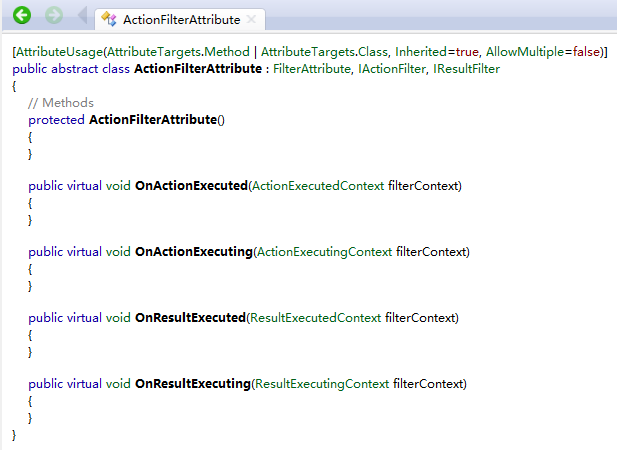
不难看出,ActionFilterAttribute共有四个虚方法和一个可被继承构造函数,而四个虚方法,分别是IAcionFilter接口和IResultFilter方法签名的原型。
四个虚方法,在上面我们已经分析过,这里就不分析了,重点分析一下这四个方法的执行顺序:
=》Request ip=>Route(路由器寻找具体Controller和action)=>执行action上面的特性=》OnActionExecutiong=》执行方法=》OnActionExecuted=》OnResultExecuting=》执行操作结果=》OnResultExecuted=》将执行结果最终Responce给浏览器。
源码:
public class ExeOrderTestAttribute:ActionFilterAttribute
{
public override void OnActionExecuted(ActionExecutedContext filterContext)
{
Log("OnActionExecuted", filterContext.RouteData);
base.OnActionExecuted(filterContext);
}
public override void OnActionExecuting(ActionExecutingContext filterContext)
{
Log("OnActionExecuting", filterContext.RouteData);
base.OnActionExecuting(filterContext);
}
public override void OnResultExecuted(ResultExecutedContext filterContext)
{
Log("OnResultExecuted", filterContext.RouteData);
base.OnResultExecuted(filterContext);
}
public override void OnResultExecuting(ResultExecutingContext filterContext)
{
Log("OnResultExecuting", filterContext.RouteData);
base.OnResultExecuting(filterContext);
}
private void Log(string methodName, RouteData routeData)
{
var controllerName = routeData.Values["controller"];
var actionName = routeData.Values["action"];
var message = String.Format("{0} controller: {1} action: {2}", methodName, controllerName, actionName);
Debug.WriteLine(message, "ASP.NET MVC Filter ExecuteOrder");
}
}
(三)其他类
从上面的继承图中可以看出,ASP.NET MVC过滤机制,处理定义接口,抽象类外,还有一些其他基础类,比较关键的类有:OutputCacheAttribute,ValidateInpuntAttribute,AuthorizeAttribute和ValidateAntiForgeryTokenAttribute。
1.OutputCacheAttribute
该类主要是解决Cache问题,感兴趣的,可以看看浅谈缓存技术在ASP.NET中的运用 ,这里不累述。
2.ValidateInpuntAttribute 和ValidateAntiForgeryTokenAttribute
主要解决表单验证问题,如防止漏洞注入,JS注入等问题。
3.AuthorizeAttribute
该类主要解决资源授权问题,也就是平时大家所说的权限管等问题,是非常重要的一个类,因此将在本篇文章的第二部分单独讲解。
二 MVC框架授权机制
ASP.NET MVC框架通过AuthorizeAttribute类实现资源的权限控制访问。
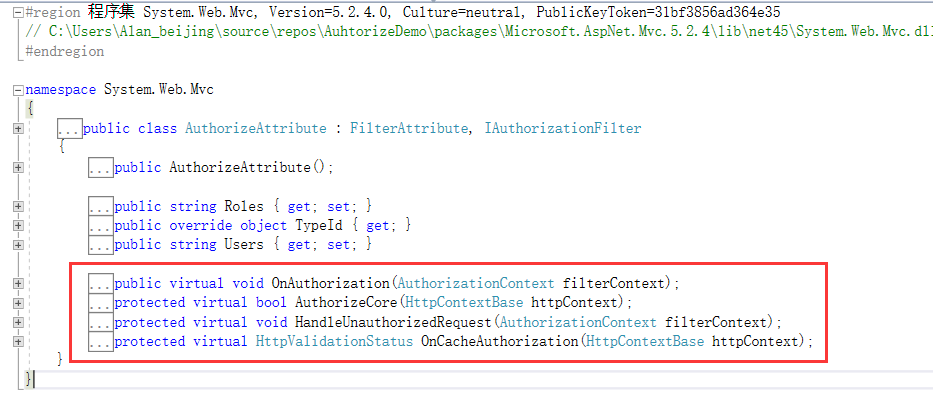
我们先来通过反汇编看看AuthorizeAttribute。
[AttributeUsage(AttributeTargets.Method | AttributeTargets.Class, Inherited=true, AllowMultiple=true)]
public class AuthorizeAttribute : FilterAttribute, IAuthorizationFilter
{
// Fields
private string _roles;
private string[] _rolesSplit = new string[];
private static readonly char[] _splitParameter = new char[] { ',' };
private readonly object _typeId = new object();
private string _users;
private string[] _usersSplit = new string[]; // Methods
protected virtual bool AuthorizeCore(HttpContextBase httpContext)
{
if (httpContext == null)
{
throw new ArgumentNullException("httpContext");
}
IPrincipal user = httpContext.User;
if (!user.Identity.IsAuthenticated)
{
return false;
}
if ((this._usersSplit.Length != ) && !this._usersSplit.Contains<string>(user.Identity.Name, StringComparer.OrdinalIgnoreCase))
{
return false;
}
if ((this._rolesSplit.Length != ) && !this._rolesSplit.Any<string>(new Func<string, bool>(user.IsInRole)))
{
return false;
}
return true;
} private void CacheValidateHandler(HttpContext context, object data, ref HttpValidationStatus validationStatus)
{
validationStatus = this.OnCacheAuthorization(new HttpContextWrapper(context));
} protected virtual void HandleUnauthorizedRequest(AuthorizationContext filterContext)
{
filterContext.Result = new HttpUnauthorizedResult();
} public virtual void OnAuthorization(AuthorizationContext filterContext)
{
if (filterContext == null)
{
throw new ArgumentNullException("filterContext");
}
if (OutputCacheAttribute.IsChildActionCacheActive(filterContext))
{
throw new InvalidOperationException(MvcResources.AuthorizeAttribute_CannotUseWithinChildActionCache);
}
if (!filterContext.ActionDescriptor.IsDefined(typeof(AllowAnonymousAttribute), true) && !filterContext.ActionDescriptor.ControllerDescriptor.IsDefined(typeof(AllowAnonymousAttribute), true))
{
if (this.AuthorizeCore(filterContext.HttpContext))
{
HttpCachePolicyBase cache = filterContext.HttpContext.Response.Cache;
cache.SetProxyMaxAge(new TimeSpan(0L));
cache.AddValidationCallback(new HttpCacheValidateHandler(this.CacheValidateHandler), null);
}
else
{
this.HandleUnauthorizedRequest(filterContext);
}
}
} protected virtual HttpValidationStatus OnCacheAuthorization(HttpContextBase httpContext)
{
if (httpContext == null)
{
throw new ArgumentNullException("httpContext");
}
if (!this.AuthorizeCore(httpContext))
{
return HttpValidationStatus.IgnoreThisRequest;
}
return HttpValidationStatus.Valid;
} internal static string[] SplitString(string original)
{
if (string.IsNullOrEmpty(original))
{
return new string[];
}
return original.Split(_splitParameter).Select((<>c.<>9__19_0 ?? (<>c.<>9__19_0 = new Func<string, <>f__AnonymousType1<string, string>>(<>c.<>.<SplitString>b__19_0)))).Where((<>c.<>9__19_1 ?? (<>c.<>9__19_1 = new Func<<>f__AnonymousType1<string, string>, bool>(<>c.<>.<SplitString>b__19_1)))).Select((<>c.<>9__19_2 ?? (<>c.<>9__19_2 = new Func<<>f__AnonymousType1<string, string>, string>(<>c.<>.<SplitString>b__19_2)))).ToArray<string>();
} // Properties
public string Roles
{
get
{
return (this._roles ?? string.Empty);
}
set
{
this._roles = value;
this._rolesSplit = SplitString(value);
}
} public override object TypeId
{
get
{
return this._typeId;
}
} public string Users
{
get
{
return (this._users ?? string.Empty);
}
set
{
this._users = value;
this._usersSplit = SplitString(value);
}
} // Nested Types
[Serializable, CompilerGenerated]
private sealed class <>c
{
// Fields
public static readonly AuthorizeAttribute.<>c <> = new AuthorizeAttribute.<>c();
public static Func<string, <>f__AnonymousType1<string, string>> <>9__19_0;
public static Func<<>f__AnonymousType1<string, string>, bool> <>9__19_1;
public static Func<<>f__AnonymousType1<string, string>, string> <>9__19_2; // Methods
internal <>f__AnonymousType1<string, string> <SplitString>b__19_0(string piece)
{
return new { piece = piece, trimmed = piece.Trim() };
} internal bool <SplitString>b__19_1(<>f__AnonymousType1<string, string> <>h__TransparentIdentifier0)
{
return !string.IsNullOrEmpty(<>h__TransparentIdentifier0.trimmed);
} internal string <SplitString>b__19_2(<>f__AnonymousType1<string, string> <>h__TransparentIdentifier0)
{
return <>h__TransparentIdentifier0.trimmed;
}
}
} Collapse Methods
通过反汇编,得出如下结论:
1.提供四个虚方法OnAuthorization(AuthorizationContext filterContext),AuthorizeCore(HttpContextBase httpContext),HandleUnauthorizedRequest(AuthorizationContext filterContext)和OnCacheAuthorization(HttpContextBase httpContext)。
四个方法作用和关系是怎样的呢
OnAuthorization表示请求过程时身份验证,AuthorizeCore表示支持用户自定义身份验证,HandleUnauthorizeRequest表示当AuthorizeCore方法验证失败时,执行的操作,OnCacheAuthorization表示模块缓存权限。
(一) ASP.NET MVC 基架提供的验证
只需在需要验证的资源生加上[Authorize]特性即可。
[Authorize]
public ActionResult Index()
{
return View(); ;
}
(二) 实现自定义验证机制
当未给Index() action添加验证限制时,匿名用户名能直接访问 /Default/Index

当给Index() action添加验证限制时,匿名用户名不能直接访问 /Default/Index,而被强制重定型到登陆页面,要求用户登陆。

(三) ASP.NET MVC验证级别
ASP.NET MVC提供了四种基本验证模式:匿名,全局,控制器和Action
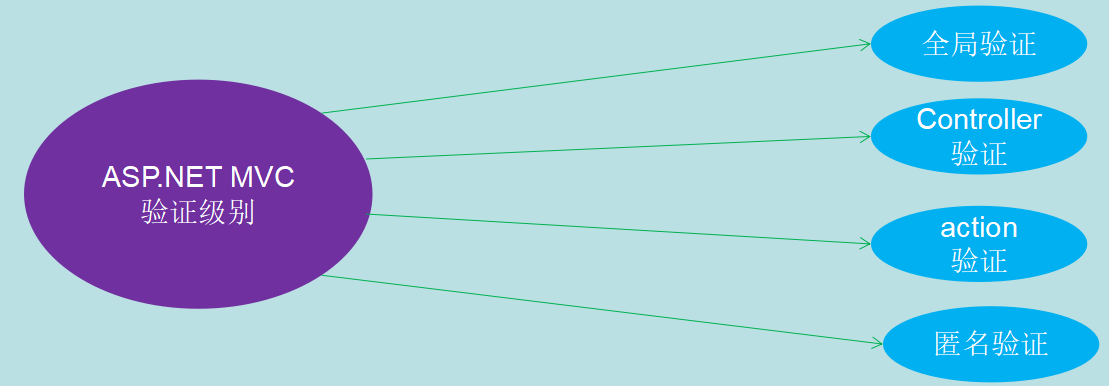
1.匿名
public class DefaultController : Controller
{
[AllowAnonymous]
public ActionResult Index()
{
return View();
}
}
2.action
public class DefaultController : Controller
{
[CustomAuthorize]
public ActionResult Index()
{
return View();
}
}
3.Controller
[CustomAuthorize]
public class DefaultController : Controller
{
public ActionResult Index()
{
return View();
}
}
4.全局
public class FilterConfig
{
public static void RegisterGlobalFilters(GlobalFilterCollection filters)
{
filters.Add(new CustomAuthorizeAttribute());//给自定义验证注册
filters.Add(new HandleErrorAttribute());
}
}
扩展,当添加多个验证时,程序时如何执行的?通古Order值顺序执行
[Filter1(Order = )]
[Filter2(Order = )]
[Filter3(Order = )]
public ActionResult Index()
{
return View(); ;
}
三 总结
本篇文章主要从ASP.NET MVC框架设计角度,运用PD工具,通过UML分析ASP.NET MVC是如何实现资源过滤,如何实现权限控制等功能的,更细粒度的技术文章,在后续博文中更新。
【ASP.NET MVC系列】浅谈ASP.NET MVC资源过滤和授权的更多相关文章
- MVC模式浅谈
MVC模式浅谈 一.MVC模式概述 模型-视图-控制器(MVC模式)是一种非常经典的软件架构模式,在UI框架和UI设计思路中扮演着非常重要的角色.从设计模式的角度来看,MVC模式是 一种复合模式,它将 ...
- 【ASP.NET MVC系列】浅谈ASP.NET MVC八大类扩展(上篇)
lASP.NET MVC系列文章 [01]浅谈Google Chrome浏览器(理论篇) [02]浅谈Google Chrome浏览器(操作篇)(上) [03]浅谈Google Chrome浏览器(操 ...
- 【ASP.NET MVC系列】浅谈ASP.NET 页面之间传值的几种方式
ASP.NET MVC系列文章 [01]浅谈Google Chrome浏览器(理论篇) [02]浅谈Google Chrome浏览器(操作篇)(上) [03]浅谈Google Chrome浏览器(操作 ...
- 【ASP.NET MVC系列】浅谈ASP.NET MVC运行过程
ASP.NET MVC系列文章 [01]浅谈Google Chrome浏览器(理论篇) [02]浅谈Google Chrome浏览器(操作篇)(上) [03]浅谈Google Chrome浏览器(操作 ...
- 【ASP.NET MVC系列】浅谈ASP.NET MVC 视图
ASP.NET MVC系列文章 [01]浅谈Google Chrome浏览器(理论篇) [02]浅谈Google Chrome浏览器(操作篇)(上) [03]浅谈Google Chrome浏览器(操作 ...
- 【ASP.NET MVC系列】浅谈ASP.NET MVC 视图与控制器传递数据
ASP.NET MVC系列文章 [01]浅谈Google Chrome浏览器(理论篇) [02]浅谈Google Chrome浏览器(操作篇)(上) [03]浅谈Google Chrome浏览器(操作 ...
- 【ASP.NET MVC系列】浅谈ASP.NET MVC 控制器
ASP.NET MVC系列文章 [01]浅谈Google Chrome浏览器(理论篇) [02]浅谈Google Chrome浏览器(操作篇)(上) [03]浅谈Google Chrome浏览器(操作 ...
- 【ASP.NET MVC系列】浅谈ASP.NET MVC 路由
ASP.NET MVC系列文章 [01]浅谈Google Chrome浏览器(理论篇) [02]浅谈Google Chrome浏览器(操作篇)(上) [03]浅谈Google Chrome浏览器(操作 ...
- 【ASP.NET MVC系列】浅谈ASP.NET 程序发布过程
ASP.NET MVC系列文章 [01]浅谈Google Chrome浏览器(理论篇) [02]浅谈Google Chrome浏览器(操作篇)(上) [03]浅谈Google Chrome浏览器(操作 ...
- 浅谈ASP.NET ---- 系列文章
[01]浅谈Google Chrome浏览器(理论篇) [02]浅谈Google Chrome浏览器(操作篇)(上) [03]浅谈Google Chrome浏览器(操作篇)(下) [04]浅谈ASP. ...
随机推荐
- (PMP)第2章-----项目运行环境
1.事业环境因素:(客观存在,可能有帮助或阻碍,项目经理必须遵守) 内部:文化,结构,治理:设施和资源的地理分布,基础设施,信息技术软件,资源可用性,员工能力 外部:市场条件,社会和文化,法律限制,商 ...
- 神经网络参数与TensorFlow变量
在TensorFlow中变量的作用是保存和更新神经网络中的参数,需要给变量指定初始值,如下声明一个2x3矩阵变量 weights =tf.Variable(tf.random_normal([2,3] ...
- PowerShell工作流学习-7-编写脚本工作流帮助
关键点: a)工作流中不支持基于注释的帮助(标识工作流的帮助文件的 .ExternalHelp 注释除外). b)支持get-help参数的方式:使用 .ExternalHelp 注释以便 Get-H ...
- Ubuntu安装pyenv实现python多版本控制
Ubuntu安装pyenv实现python多版本控制 git clone git://github.com/yyuu/pyenv.git ~/.pyenv echo 'export PYENV_ROO ...
- jquery,html5,css3主要特性总结
jquery特性: 1.丰富简单的DOM选择器 2.同一函数实现get和set 3.支持链式方法书写 4.完善的事件处理功能 5.强大的css动画效果 6.完善的Ajax 7.简单的元素样式操作 8. ...
- Java实现对文本文件MD5加密并ftp传送到远程主机目录
需求描述: 客户出完账之后需要把出账的数据以文本文件的方式传送给收入管理系统,客户以前是通过本地的一个工具软件上传的,由于安全监管的原因,不允许在本地使用工具上传,因此客户希望我们在已经上线使用的系统 ...
- 在注册表中查看Windows10系统激活密钥的方法
1 2 3 4 5 6 7 分步阅读 百度经验:jingyan.baidu.com 激活Windows10系统(非自己使用激活密钥激活的系统)以后,我们不一定清楚激活密钥是什么.如果想查看自己电脑 ...
- delphi压缩与解压_不需要特别的控件
unit unzip; interface uses Windows, Messages, SysUtils, Variants, Classes, Graphics, Controls, Forms ...
- [转] Vmware vs Virtualbox vs KVM vs XEN: virtual machines performance comparison
http://www.ilsistemista.net/index.php/virtualization/1-virtual-machines-performance-comparison.html? ...
- redis主从架构,分片集群详解
写在前面:这篇笔记有点长,如果你认真看完,收获会不少,如果你只是忘记了相关命令,请翻到末尾. redis的简单介绍: 一个提供多种数据类类型储存,整个系统都在内存中运行的, 定期通过异步的方式把数据刷 ...
